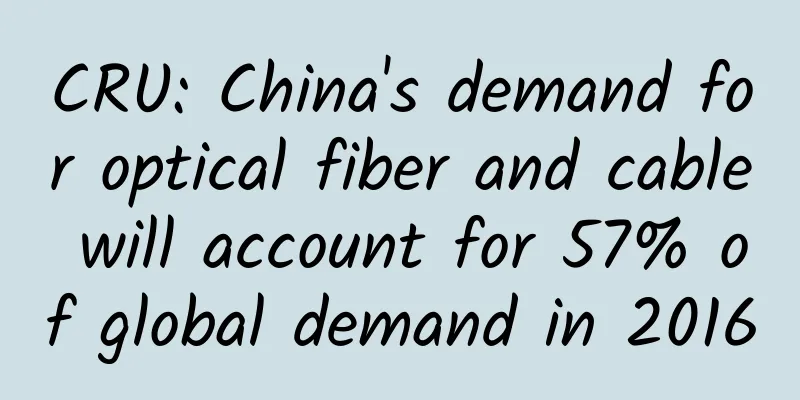CRU: China's demand for optical fiber and cable will account for 57% of global demand in 2016

|
John Johnson, president of CRU China, predicted that global demand for optical fiber and cable will reach 425 million core kilometers in 2016, of which China will account for 57%.
At the 2017 Hengtong Group Media Interactive Exchange Conference held recently, Johnson delivered a keynote speech entitled "The Chinese Market Determines the Global Optical Fiber and Cable Industry Landscape", sharing CRU's views on the current status and future prospects of the global optical fiber and cable market, and particularly emphasized that "China accounts for the largest share of global optical fiber demand" and "as China's demand is higher than expected, global optical fiber and cable demand will hit a new high in 2016." The report said that the global demand for optical fiber and cable has exceeded 400 million core kilometers, and China's strong demand is still the main driving force, which will continue to lead the global growth trend. The demand in North America and the Asia-Pacific market outside China has maintained an upward trend; the demand growth in Western Europe has increased significantly, and the Eastern European market is also gradually recovering. At the same time, China's fiber optic deployment is developing at an extraordinary speed. Johnson compared it with the United States, saying that China's cumulative fiber optic installation volume is comparable to that of the United States, but in a very short time. With the widespread coverage of 4G and fiber-to-the-home, will China's fiber optic cable growth reach saturation? CRU believes not. From 2010 to 2015, the average annual growth rate of global Internet traffic reached 29%, which means that fiber optic cable as infrastructure will still be the focus of investment. The huge demand is one thing, but more importantly, China's cable manufacturing industry is also rising strongly. Chinese manufacturers are expanding their production capacity at an astonishing rate, and they are also maintaining an aggressive attitude in optical fiber preforms. Johnson pointed out that several large preforms will be put on the market in 2017, but before that, the shortage of preform supply will limit the growth of demand to a certain extent. |
<<: China Telecom faces four major challenges in network reconstruction of SDN/NFV practice
Recommend
ZJI newly launched Hong Kong one machine three lines (Kwai Wan/Alibaba Cloud/Huawei Cloud) server, 20% off monthly payment starting from 800 yuan
ZJI is a well-known hosting company in the WordPr...
WOT Li Jian: The evolution of the eleme container platform
[51CTO.com original article] The Global Software ...
At the 2017 Asia Pacific CDN Annual Conference, Yunfan Accelerator was awarded the title of "Excellent Service Quality Enterprise"
On November 14, 2017, the 2017 Asia-Pacific CDN A...
What is structured cabling? What are the benefits of structured cabling?
In the world of cabling, the term structured cabl...
Dewu App intercepts WiFi at 10,000 meters
0. Summary of the previous situation During a fli...
Do you really understand API Gateway? This article explains the differences and integration between microservice gateway and enterprise application gateway
Software architecture is always evolving and iter...
FAA announces agreement with AT&T, Verizon to expand C-band 5G signals
The Federal Aviation Administration (FAA) said it...
Ruijie Networks escorts Guangzhou's "Digital Asian Games"
With the Chinese women's volleyball team'...
China Unicom SMS has a large-scale failure: mobile phones cannot receive verification codes. Official: Emergency processing is in progress
On February 10, the last working day, China Unico...
Lenovo Huang Ying: 6G will be a "super channel" connecting the virtual and real worlds under full intelligent applications
On June 28, the MWC Shanghai World Mobile Communi...
China Unicom opens two submarine optical cables: 100Gbps connecting Europe, Asia and Africa
Recently, China Unicom officially announced that ...
WePC: Netherlands VPS backhaul CN2/AS9929 starting at 24 yuan per month - 512MB/10G NVMe/400GB@200Mbps (limited speed upon reaching capacity)
WePC uses the .au domain name and describes itsel...
【Funny story】An attack launched by a network cable
Not long after I entered college, I encountered a...
How does network latency occur?
Network latency Network delay refers to the time ...
Critical documentation in data center transformation
Documentation is often neglected in IT work. When...









